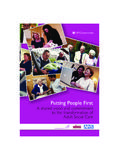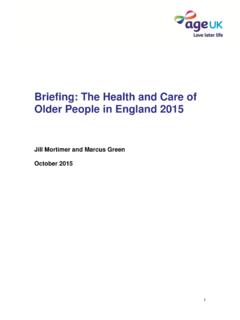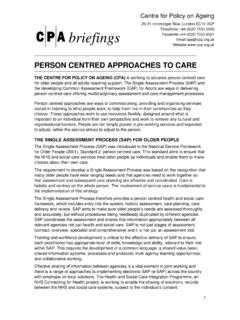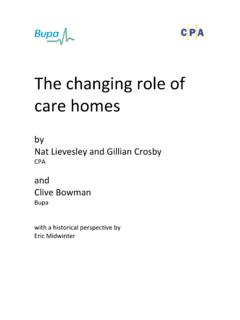Transcription of Local Authority Circular LAC (DH) (2008) 1 - CPA
1 Local Authority Circular LAC (DH) (2008) 1 To: The Chief Executive County Councils ) Metropolitan District Councils ) England Shire Unitary Councils ) London Borough Councils Common Council of the City of London Council of the Isles of Scilly Director of Adult Social Services Councils with Social Service Responsibilities in England Copied to: Chief Executive Strategic Health Authorities Chief Executive Primary Care Trust Regional Directors of Public Health Government Office Directors Regional Directors, CSIP RDCs Date: 17 January 2008 Gateway Reference: 9337 TRANSFORMING SOCIAL CARE 1.
2 This Local Authority Circular sets out information to support the transformation of social care signalled in the Department of Health s social care Green Paper, Independence, Well-being and Choice (2005) and reinforced in the White Paper, Our health, our care, our say: a new direction for community services in 2006. The approach was confirmed in the landmark putting people first Concordat1 between six Government Departments, the Local Government Association, the Association of Directors of Adult Social Services, the NHS, representatives of independent sector providers, the Commission for Social Care Inspection and other partners, published in December 2007. There are four sections to this Circular : Part 1: (Pages 2-8) looks at what needs to be done, the vision for development of a personalised approach to the delivery of adult social care, the history and the context in which this policy is grounded.
3 Part 2: (Pages 9-15) sets out how the Department of Health (DH) and sector leaders propose to develop a sector led programme to support councils with social service responsibilities in delivering this modernisation agenda. Annex A: (Pages 16-26) is a copy of the Social Care Reform Grant Determination. It sets out the details of the new ring-fenced grant to help councils to redesign and reshape their systems over the next 3 years. Annex B: (Page 27) Is a list of useful websites. 1 putting people first : a shared vision and commitment to the transformation of Adult Social Care, HMG, LAC (DH) (2008) 1 PART 1: A PERSONALISED APPROACH Introduction 2. Consultation responses to the White Paper2 confirmed that people want access to support when they need it and they expect it to be available to them quickly, easily and fit into their lives.
4 They also want adult social care services to make provision for a range of needs with a greater focus on using preventative approaches to promote people s independence and wellbeing. The emphasis should be on enablement and early intervention to promote independence rather than involvement at the point of crisis, within the framework of Fair Access to Care Services. 3. To make this happen the sector needs a shared vision. The direction is clear: to make personalisation, including a strategic shift towards early intervention and prevention, the cornerstone of public services. In social care, this means every person across the spectrum of need, having choice and control over the shape of his or her support, in the most appropriate setting. For some, exercising choice and control will require a significant level of assistance either through professionals or through independent advocates.
5 4. This is a challenging agenda, which cannot be delivered by social care alone. To achieve this sort of transformation will mean working across the boundaries of social care such as housing, benefits, leisure and transport and health. It will mean working across the sector with partners from independent, voluntary and community organisations to ensure a strategic balance of investment in Local services. This will range from support for those with emerging needs, to enabling people to maintain their independence and to supporting those with high-level complex needs. When considering transformation partners should look at resources spent through mainstream services, the NHS, housing and other relevant statutory agencies, the voluntary and private sectors, and not just those resources spent via the adult social services department.
6 5. The new Local Performance Framework will be of fundamental importance in supporting this to happen. Primary Care Trusts and Local Authorities are working in the Local Strategic Partnerships (LSPs) to agree new Joint Strategic Needs Assessments. Joint Strategic Needs Assessments (JSNAs) will provide the foundation for health and wellbeing outcomes within each new Local Area Agreement (LAA). Our ambitions for modernising social care sit entirely within this Framework. 6. The importance of this holistic approach is recognised and underpinned by putting people first : A shared vision and commitment to the transformation of Adult Social Care , a concordat that establishes a collaborative approach between central and Local Government, the sector s professional leadership, providers and the regulator.
7 It sets out the shared aims and values, which will guide the transformation of adult social care. 7. Across Government, the shared ambition is to meet the aspiration to put people first through a radical reform of public services. It will mean that people are able to live their own lives as they wish, confident that services are of high quality, are safe and promote their own individual requirements for independence, well-being and dignity. Local priority setting will be focused on meeting Local needs and playing a leading role in 2 Our health, our care, our say: a new direction for community services, Department of Health (2006) 2 LAC (DH) (2008) 1 shaping strong and cohesive Local communities3.
8 This document sets out the contribution of social services, working in partnership across Local Strategic Partnerships, to support Local leaders and their partners to make this happen. Context: Why change is needed 8. Advances in public health, healthcare and changes in society mean that we are living longer, and as communities become more diverse, the challenges of supporting that diversity becomes more apparent. people have higher expectations of what they need to meet their own particular circumstances, wanting greater control over their lives and the risks they take. They want dignity and respect to be at the heart of any interaction, so that they can access high-quality services and support closer to home at the right time, enabling them and their supporters to maintain or improve their wellbeing and independence rather than relying on intervention at the point of crisis.
9 Social care cannot meet these challenges without radical change in how services are delivered. 9. The change in the structure of our population is one of the most significant challenges we face in the 21st century. Life expectancy has increased considerably with a doubling of the number of older people since 19314. Between 2006 and 2036, the number of people over 85 in England will rise from to million5, an increase of approximately 180%. This trend will continue (eg the numbers of people with dementia in England, around 560,0006 in 2007, is expected to double in the next 30 years) and with it, demand for support across the continuum of need will increase. In addition, the numbers of people aged 50 and over with learning disabilities are projected to rise by 53% between 2001 and 20217.
10 And, thanks to advances in medicine, more children with complex needs are surviving into adulthood. We need to recognise their aspirations and their desire to live life as fully as possible. 10. More people are being supported to live independently at home, but at the same time resouces are increasingly targeted at those with the greatest need8910. This is despite emerging evidence from the Partnership for Older people Projects (POPPs) which indicates that earlier interventions before people reach high levels of need may be more cost-effective for the heath and social care system and provide better outcomes for individuals. This is also reflected in the Office for Disability Issues report Better outcomes, lower costs into housing adaptations11. 11. Supported by the DH s efficiency programme, councils have increasing shown how developing homecare re-ablement services can support independent living and deliver value for money.


















